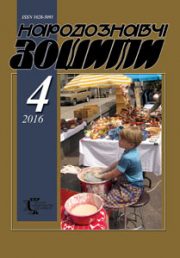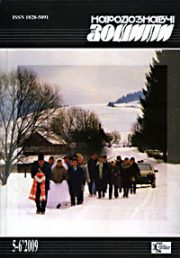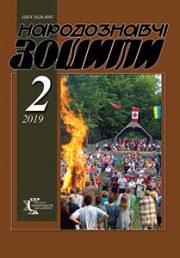The Ethnology Notebooks. 2018, № 4 (142), 989–999
UDK 394.2:[398.8(=161.2):7.089](477)”199/20”
DOI https://doi.org/10.15407/nz2018.04.989
Received 07.05.2018
INCLUDED CUMULATION IN UKRAINIAN FOLK FAIRYTALES
Trebyk Olga – State University of Telecommunications.
street of Solom’jans’ka, 7, Kyiv, 03680
Contacts: e–mail: awaywith@I.UA
Abstrakt. Structural-compositional analysis of twenty five actual cumulative included fairy–tales is carried out in the article. An analysis of fairy tales according to their plot, determined by the Aarne–Thompson index, is presented. According to the features of the inclusion of characters, fabulous cumulative structures with the included cumulation are divided into two main categories: implicit included cumulation and explicit included cumulation.
Keywords: cumulative fairy tale, explicitincluded cumulation, implicit included cumulation, included cumulation, fair–ytale story
REFERENCES
Afanas’ev, A.N. (1984). Narodnye russkye skazky: v 3 t. (T. 1). Moskva: Nauka [in Russian].
Berezovs’kyj, I.P. (1979). Pokhodzhennia ta prymitky. In Berezovs’kyj, I. (Ed.), Ukrains’ki narodni kazky pro tvaryn (pp. 511–550). Kyiv: Naukova dumka [in Ukrainian].
Berezovs’kyj, I.P. (Ed.). (1979). Ukrains’ki narodni kazky pro tvaryn. Kyiv: Naukova dumka [in Ukrainian].
Bobyr, O. (Ed.). (2016). Slovnyk–dovidnyk literaturoznavchykh terminiv. Chernihiv: Desna Polihraf, [in Ukrainian].
Davydiuk, V.F. (1996). Istorychna symvolika ukrains’koi kumuliatyvnoi kazky. Fol’klorystychni zoshyty, 1, 13–35, Luts’k: Vezha [in Ukrainian].
Davydiuk, V.F. (2005). Pervisna mifolohiia ukrains’koho fol’kloru. Luts’k: Volyns’ka oblasna drukarnia, [in Ukrainian].
Kapytsa, O.Y. (1928). Detskyj fol’klor. Pesny, poteshky, draznylky, skazky, ihry. Lenynhrad: Pryboj [in Russian].
Koval’ V.Y. (2011). Skazka o kolobke: tekst, podtekst, arkhaychnaia symvolyka. Mova i kul’tura: Naukovyj zhurnal, 14, V, (151), 54–61, Kyiv: Vyd. dim Dmytra Buraho [in Russian].
Kretov, A.A. (1994). Skazky rekursyvnoj struktury. Trudy po russkoj y slavianskoj fylolohyy; Lyteraturovedenye, I, 204–214 [in Russian].
Nykyforov, A.Y. (1928). Narodnaia detskaia skazka dramatycheskoho zhanra (pp. 49–63). Lenynhrad [in Russian].
Pomerantseva, E.V. (1963). Russkaia narodnaia skazka, Moskva [in Russian].
Pomerantseva, E.V. (1965). Sud’by russkoj skazky, Moskva [in Russian].
Ppopp, V.Ya. (1984). Russkaia skazka. Lenynhrad [in Russian].
Propp, V.Ya. Kumuliatyvnaia skazka. Fol’klor y dejstvytel’–nost’: Yzbrannye stat’y (241–257). Moskva: Nauka, [in Russian].
Rudchenko, Y. (1869). Narodnye iuzhnorusskye skazky. Vypusk 1, Kyev, S. V–XI [in Russian].
Tolstoj, N.Y. (1995). Sekret Kolobka. Zhyvaia staryna, 3 (7), 41–42 [in Russian].
Troytskaia, T.S. (1999). Skazka «Teremok»: lohyka ynvaryanta y predely var’yro–vanyia. Tradytsyia y lyteraturnyj protsess (pp. 164–176 ). Novosybyrsk: RAN [in Russian].
Aarne, A. (1910). Verzeichnis der Marchentypen. FF Communications, 3. Helsinki, [in German].
Aarne A. (1927, 1961). The Types of the Folk–Tale. A Classification and Bibliography. FF Comunications, 74, 184 Helsinki [in German].
Bolte, J. (1913). Anmerkungen zu den Kinder – und Hausmarchen der Bruder Grimm. Leipzig: Dieterichschen Buchhandlung [in German].
Haavio, M. (1929). Kettenmarchenstudien. FF Communications, 88, 64–93. Helsinki [in German].
Kretov, A.A. Rekursyvnye skazky–2. Retrieved from: http://www.ruthenia.ru/folklore/kretov1.htm.
Lozovskaia, N.V. Varyanty skazochnoho siuzheta typa AT 2025 «Kolobok». Retrieved from: http://lozovska.narod.ru/html.
Smyrnova, S. Tak ly prost kolobok, kak kazhetsia? Retrieved from: http://bookmix.ru/news/index.phtml?id=966.







